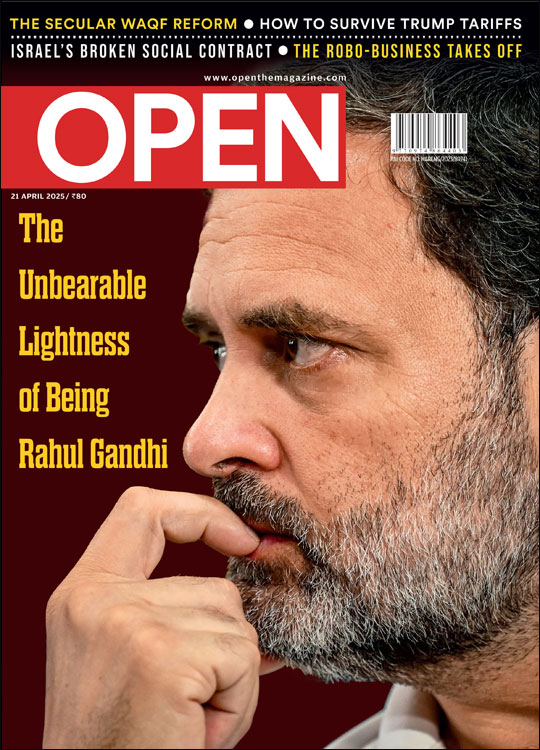Some Fake News Lasts For Ever
Homo Sapiens is a post-truth species, whose power depends on creating and believing fictions
 Yuval Noah Harari
Yuval Noah Harari
 Yuval Noah Harari
|
30 Aug, 2018
Yuval Noah Harari
|
30 Aug, 2018
/wp-content/uploads/2018/08/Fakenews1.jpg)
WE ARE REPEATEDLY TOLD THESE days that we are living in a new and frightening era of ‘post-truth’, and that lies and fictions are all around us. Examples are not hard to come by. Thus in late February 2014 Russian special units bearing no army insignia invaded Ukraine and occupied key installations in Crimea. The Russian government and President Putin in person repeatedly denied that these were Russian troops, and described them as spontaneous ‘self-defence groups’ that may have acquired Russian-looking equipment from local shops. As they voiced this rather preposterous claim, Putin and his aides knew perfectly well that they were lying.
Russian nationalists can excuse this lie by arguing that it served a higher truth. Russia was engaged in a just war, and if it is OK to kill for a just cause, surely it is also OK to lie? The higher cause that allegedly justified the invasion of Ukraine was the preservation of the sacred Russian nation. According to Russian national myths, Russia is a sacred entity that has endured for a thousand years despite repeated attempts by vicious enemies to invade and dismember it. Following the Mongols, the Poles, the Swedes, Napoleon’s Grande Armée and Hitler’s Wehrmacht, in the 1990s it was NATO, the USA and the EU that attempted to destroy Russia by detaching parts of its body and forming them into ‘fake countries’ such as Ukraine. For many Russian nationalists, the idea that Ukraine is a separate nation from Russia constitutes a far bigger lie than anything uttered by President Putin during his holy mission to reintegrate the Russian nation.
Ukrainian citizens, outside observers and professional historians may well be outraged by this explanation, and regard it as a kind of ‘atom-bomb lie’ in the Russian arsenal of deception. To claim that Ukraine does not exist as a nation and as an independent country disregards a long list of historical facts—for example, that during the thousand years of supposed Russian unity, Kyiv and Moscow were part of the same country for only about 300 years. It also violates numerous international laws and treaties that Russia has previously accepted and that have safeguarded the sovereignty and borders of independent Ukraine. Most importantly, it ignores what millions of Ukrainians think about themselves. Don’t they have a say about who they are?
Ukrainian nationalists would certainly agree with Russian nationalists that there are some fake countries around. But Ukraine isn’t one of them. Rather, these fake countries are the ‘Luhansk People’s Republic’ and the ‘Donetsk People’s Republic’ that Russia has set up to mask its unprovoked invasion of Ukraine.
Whichever side you support, it seems that we are indeed living in a terrifying era of post-truth, when not just particular military incidents, but entire histories and nations might be faked. But if this is the era of post-truth, when, exactly, was the halcyon age of truth? In the 1980s? The 1950s? The 1930s? And what triggered our transition to the post-truth era—the Internet? Social media? The rise of Putin and Trump?
A cursory look at history reveals that propaganda and disinformation are nothing new, and even the habit of denying entire nations and creating fake countries has a long pedigree. In 1931 the Japanese army staged mock attacks on itself to justify its invasion of China, and then created the fake country of Manchukuo to legitimise its conquests. China itself has long denied that Tibet ever existed as an independent country. British settlement in Australia was justified by the legal doctrine of terra nullius (‘nobody’s land’), which effectively erased 50,000 years of Aboriginal history.
In the early twentieth century a favourite Zionist slogan spoke of the return of ‘a people without a land [the Jews] to a land without a people [Palestine]’. The existence of the local Arab population was conveniently ignored. In 1969 Israeli prime minister Golda Meir famously said that there is no Palestinian people and never was. Such views are very common in Israel even today, despite decades of armed conflicts against something that doesn’t exist. For example, in February 2016 MP Anat Berko gave a speech in the Israeli Parliament in which she doubted the reality and history of the Palestinian people. Her proof? The letter ‘p’ does not even exist in Arabic, so how can there be a Palestinian people? (In Arabic, ‘f’ stands for ‘p’, and the Arabic name for Palestine is Falastin.)
The Post-Truth Species
In fact, humans have always lived in the age of post-truth. Homo sapiens is a post-truth species, whose power depends on creating and believing fictions. Ever since the Stone Age, self-reinforcing myths have served to unite human collectives. Indeed, Homo sapiens conquered this planet thanks above all to the unique human ability to create and spread fictions. We are the only mammals that can cooperate with numerous strangers because only we can invent fictional stories, spread them around, and convince millions of others to believe in them. As long as everybody believes in the same fictions, we all obey the same laws, and can thereby cooperate effectively.
So if you blame Facebook, Trump or Putin for ushering in a new and frightening era of post-truth, remind yourself that centuries ago millions of Christians locked themselves inside a self- reinforcing mythological bubble, never daring to question the factual veracity of the Bible, while millions of Muslims put their unquestioning faith in the Quran. For millennia, much of what passed for ‘news’ and ‘facts’ in human social networks were stories about miracles, angels, demons and witches, with bold reporters giving live coverage straight from the deepest pits of the underworld. We have zero scientific evidence that Eve was tempted by the Serpent, that the souls of all infidels burn in hell after they die, or that the creator of the universe doesn’t like it when a Brahmin marries an Untouchable—yet billions of people have believed in these stories for thousands of years. Some fake news lasts for ever.
I am aware that many people might be upset by my equating religion with fake news, but that’s exactly the point. When a thousand people believe some made-up story for one month— that’s fake news. When a billion people believe it for a thousand years—that’s a religion, and we are admonished not to call it ‘fake news’ in order not to hurt the feelings of the faithful (or incur their wrath). Note, however, that I am not denying the effectiveness or potential benevolence of religion. Just the opposite. For better or worse, fiction is among the most effective tools in humanity’s toolkit. By bringing people together, religious creeds make large- scale human cooperation possible. They inspire people to build hospitals, schools and bridges in addition to armies and prisons. Adam and Eve never existed, but Chartres Cathedral is still beautiful. Much of the Bible may be fictional, but it can still bring joy to billions and can still encourage humans to be compassionate, courageous and creative—just like other great works of fiction, such as Don Quixote, War and Peace and Harry Potter.
Again, some people may be offended by my comparison of the Bible with Harry Potter. If you are a scientifically minded Christian you might explain away all the errors, myths and contradictions in the Bible by arguing that the holy book was never meant to be read as a factual account, but rather as a metaphorical story containing deep wisdom. But isn’t that true of Harry Potter too?
If you are a fundamentalist Christian you are more likely to insist that every word of the Bible is literally true. Let’s assume for a moment that you are right, and that the Bible is indeed the infallible word of the one true God. What, then, do you make of the Quran, the Talmud, the Book of Mormon, the Vedas, the Avesta, and the Egyptian Book of the Dead? Aren’t you tempted to say that these texts are elaborate fictions created by flesh-and-blood humans (or perhaps by devils)? And how do you view the divinity of Roman emperors such as Augustus and Claudius? The Roman Senate claimed to have the power to turn people into gods, and then expected the empire’s subjects to worship these gods. Wasn’t that a fiction? Indeed, we have at least one example in history of a false god who acknowledged the fiction with his own mouth. As noted earlier, Japanese militarism in the 1930s and early 1940s relied on a fanatical belief in the divinity of Emperor Hirohito. After Japan’s defeat Hirohito publicly proclaimed that this was not true, and that he wasn’t a god after all.
A cursory look at history reveals that propaganda and disinformation are nothing new, and even the habit of denying entire nations and creating fake countries has a long pedigree. In 1931 the Japanese army staged mock attacks on itself to justify its invasion of China, and then created the fake country of Manchukuo to legitimise its conquests
So even if we agree that the Bible is the true word of God, that still leaves us with billions of devout Hindus, Muslims, Jews, Egyptians, Romans and Japanese who for thousands of years put their trust in fictions. Again, that does not mean that these fictions are necessarily worthless or harmful. They could still be beautiful and inspiring.
Of course, not all religious myths have been equally beneficent. On 29 August 1255 the body of a nine-year-old English boy called Hugh was found in a well in the town of Lincoln. Even in the absence of Facebook and Twitter, rumour quickly spread that Hugh was ritually murdered by the local Jews. The story only grew with retelling, and one of the most renowned English chroniclers of the day—Matthew Paris—provided a detailed and gory description of how prominent Jews from throughout England gathered in Lincoln to fatten up, torture and finally crucify the abducted child. Nineteen Jews were tried and executed for the alleged murder. Similar blood libels became popular in other English towns, leading to a series of pogroms in which whole communities were massacred. Eventually, in 1290 the entire Jewish population of England was expelled.
The story didn’t end there. A century after the expulsion of the Jews from England, Geoffrey Chaucer—the Father of English literature—included a blood libel modelled on the story of Hugh of Lincoln in the Canterbury Tales (‘The Prioress’s Tale’). The tale culminates with the hanging of the Jews. Similar blood libels subsequently became a staple part of every anti-Semitic movement from late medieval Spain to modern Russia. A distant echo can even be heard in the 2016 ‘fake news’ story that Hillary Clinton headed a child-trafficking network that held children as sex slaves in the basement of a popular pizzeria. Enough Americans believed that story to hurt Clinton’s election campaign, and one person even came armed with a gun to the pizzeria and demanded to see the basement (it turned out that the pizzeria had no basement).
So if you blame Facebook, Trump or Putin for ushering in a new and frightening era of post-truth, remind yourself that centuries ago millions of Christians locked themselves inside a self-reinforcing mythological bubble, never daring to question the factual veracity of the Bible, while millions of Muslims put their unquestioning faith in the Quran
As for Hugh of Lincoln himself, nobody knows how he really found his death, but he was buried in Lincoln Cathedral and was venerated as a saint. He was reputed to perform various miracles, and his tomb continued to draw pilgrims even centuries after the expulsion of all Jews from England. Only in 1955—ten years after the Holocaust—did Lincoln Cathedral repudiate the blood libel, placing a plaque near Hugh’s tomb which reads:
Trumped-up stories of ‘ritual murders’ of Christian boys by Jewish communities were common throughout Europe during the Middle Ages and even much later. These fictions cost many innocent Jews their lives. Lincoln had its own legend and the alleged victim was buried in the Cathedral in the year 1255. Such stories do not redound to the credit of Christendom.
Well, some fake news lasts only 700 years.
Once a lie, Always the truth
Ancient religions have not been the only ones that used fiction to cement cooperation. In more recent times, each nation has created its own national mythology, while movements such as communism, fascism and liberalism fashioned elaborate self-reinforcing credos. Joseph Goebbels, the Nazi propaganda maestro and perhaps the most accomplished media-wizard of the modern age, allegedly explained his method succinctly by stating that ‘A lie told once remains a lie, but a lie told a thousand times becomes the truth.’ In Mein Kampf Hitler wrote that ‘The most brilliant propagandist technique will yield no success unless one fundamental principle is borne in mind constantly—it must confine itself to a few points and repeat them over and over.’ Can any present-day fake-news peddler improve on that?
I am aware that many people might be upset by my equating religion with fake news, but that’s exactly the point. When a thousand people believe some made-up story for one month—that’s fake news. When a billion people believe it for a thousand years—that’s a religion, and we are admonished not to call it ‘fake news’ in order not to hurt the feelings of the faithful (or incur their wrath)
The Soviet propaganda machine was equally agile with the truth, rewriting the history of everything from entire wars to individual photographs. On 29 June 1936 the official newspaper Pravda (the name means ‘truth’) carried on its front page a photo of a smiling Joseph Stalin embracing Gelya Markizova, a seven-year-old girl. The image became a Stalinist icon, enshrining Stalin as the Father of the Nation and idealising the ‘Happy Soviet Childhood’. Printing presses and factories all over the country began churning out millions of posters, sculptures and mosaics of the scene, which were displayed in public institutions from one end of the Soviet Union to the other. Just as no Russian Orthodox church was complete without an icon of the Virgin Mary holding baby Jesus, so no Soviet school could do without an icon of Papa Stalin holding little Gelya.
Alas, in Stalin’s empire fame was often an invitation to disaster. Within a year, Gelya’s father was arrested on the bogus charges that he was a Japanese spy and a Trotskyite terrorist. In 1938 he was executed, one of millions of victims of the Stalinist terror. Gelya and her mother were exiled to Kazakhstan, where the mother soon died under mysterious circumstances. What to do now with the countless icons depicting the Father of the Nation with a daughter of a convicted ‘enemy of the people’? No problem. From that moment onwards, Gelya Markizova vanished, and the ‘Happy Soviet Child’ in the ubiquitous image was identified as Mamlakat Nakhangova—a thirteen-year-old Tajik girl who earned the Order of Lenin by diligently picking lots of cotton in the fields (if anyone thought that the girl in the picture didn’t look like a thirteen-year-old, they knew better than to voice such counter-revolutionary heresy).
The Soviet propaganda machine was so efficient, that it managed to hide monstrous atrocities at home while projecting a utopian vision abroad. Today Ukrainians complain that Putin has successfully deceived many Western media outlets about Russia’s actions in Crimea and Donbas. Yet in the art of deception he can hardly hold a candle to Stalin. In the early 1930s left-wing Western journalists and intellectuals were praising the USSR as an ideal society at a time when Ukrainians and other Soviet citizens were dying in their millions from the man-made famine that Stalin orchestrated. Whereas in the age of Facebook and Twitter it is sometimes hard to decide which version of events to believe, at least it is no longer possible for a regime to kill millions without the world knowing about it.
In the art of deception Putin can hardly hold a candle to Stalin. In the early 1930s left-wing Western journalists and intellectuals were praising the USSR as an ideal society at a time when Ukrainians and other Soviet citizens were dying in their millions from the man-made famine that Stalin orchestrated
Besides religions and ideologies, commercial firms too rely on fiction and fake news. Branding often involves retelling the same fictional story again and again, until people become convinced it is the truth. What images come to mind when you think about Coca-Cola? Do you think about young healthy people engaging in sports and having fun together? Or do you think about over-weight diabetes patients lying in a hospital bed? Drinking lots of Coca-Cola will not make you young, will not make you healthy, and will not make you athletic—rather, it increases your chances of suffering from obesity and diabetes. Yet for decades Coca-Cola has invested billions of dollars in linking itself to youth, health and sports—and billions of humans subconsciously believe in this linkage.
The truth is that truth was never high on the agenda of Homo sapiens. Many people assume that if a particular religion or ideology misrepresents reality, its adherents are bound to discover it sooner or later, because they will not be able to compete with more clear-sighted rivals. Well, that’s just another comforting myth. In practice, the power of human cooperation depends on a delicate balance between truth and fiction.
If you distort reality too much, it will indeed weaken you by making you act in unrealistic ways. For example, in 1905 an East African medium called Kinjikitile Ngwale claimed to be possessed by the snake spirit Hongo. The new prophet had a revolutionary message to the people of the German colony of East Africa: unite and drive out the Germans. To make the message more appealing, Ngwale provided his followers with magic medicine that would allegedly turn German bullets into water (maji in Swahili). Thus began the Maji Maji Rebellion. It failed. For on the battlefield, German bullets didn’t turn into water. Rather, they tore mercilessly into the bodies of the ill-armed rebels. Two thousand years earlier, the Jewish Great Revolt against the Romans was similarly inspired by an ardent belief that God will fight for the Jews and help them defeat the seemingly invincible Roman Empire. It too failed, leading to the destruction of Jerusalem and the exile of the Jews.
On the other hand, you cannot organise masses of people effectively without relying on some mythology. If you stick to unalloyed reality, few people will follow you. Without myths, it would have been impossible to organise not just the failed Maji Maji and Jewish revolts, but also the far more successful rebellions of the Mahdi and the Maccabees.
In fact, false stories have an intrinsic advantage over the truth when it comes to uniting people. If you want to gauge group loyalty, requiring people to believe an absurdity is a far better test than asking them to believe the truth. If a big chief says ‘the sun rises in the east and sets in the west’, loyalty to the chief is not required in order to applaud him. But if the chief says ‘the sun rises in the west and sets in the east’, only true loyalists will clap their hands. Similarly, if all your neighbours believe the same outrageous tale, you can count on them to stand together in times of crisis. If they are willing to believe only accredited facts, what does that prove?
Besides religions and ideologies, commercial firms too rely on fiction and fake news. What images come to mind when you think about Coca-Cola? Do you think about young healthy people engaging in sports and having fun together? Or do you think about over-weight diabetes patients lying in a hospital bed? Drinking lots of Coca-Cola will not make you young, will not make you healthy, will not make you athletic— rather, it increases your chances of suffering from obesity and diabetes. Yet for decades Coca-Cola has invested billions of dollars in linking itself to youth, health and sports—and billions of humans subconsciously believe in this linkage
You might argue that at least in some cases, it is possible to organise people effectively through consensual agreements rather than through fictions and myths. Thus in the economic sphere, money and corporations bind people together far more effectively than any god or holy book, even though everyone knows that they are just a human convention. In the case of a holy book, a true believer would say ‘I believe that the book is sacred’ while in the case of the dollar, a true believer would say only that ‘I believe that other people believe that the dollar is valuable’. It is obvious that the dollar is just a human creation, yet people all over the world respect it. If so, why can’t humans abandon all myths and fictions, and organise themselves on the basis of consensual conventions such as the dollar?
Such conventions, however, are not clearly distinct from fiction. The difference between holy books and money, for example, is far smaller than it may seem at first sight. When most people see a dollar bill, they forget that it is just a human convention. As they see the green piece of paper with the picture of the dead white man, they see it is as something valuable in and of itself. They hardly ever remind themselves ‘Actually, this is a worthless piece of paper, but because other people view it as valuable, I can make use of it.’ If you observe a human brain in an fMRI scanner, you would see that as someone is presented with a suitcase full of hundred-dollar bills, the parts of the brain that start buzzing with excitement are not the sceptical parts (‘Other people believe this is valuable’) but rather the greedy parts (‘Holy shit! I want this!’). Conversely, in the vast majority of cases people begin to sanctify the Bible or the Vedas or the Book of Mormon only after long and repeated exposure to other people who view it as sacred. We learn to respect holy books in exactly the same way we learn to respect currency bills.
Hence in practice there is no strict division between ‘knowing that something is just a human convention’ and ‘believing that something is inherently valuable’. In many cases, people are ambiguous or forgetful about this division. To give another example, if you sit down and have a deep philosophical discussion about it, almost everybody would agree that corporations are fictional stories created by human beings. Microsoft isn’t the buildings it owns, the people it employs or the shareholders it serves—rather, it is an intricate legal fiction woven by lawmakers and lawyers. Yet for 99 per cent of the time, we aren’t engaged in deep philosophical discussions, and we treat corporations as if they were real entities in the world, just like tigers or humans.
Blurring the line between fiction and reality can be done for many purposes, starting with ‘having fun’ and going all the way to ‘survival’. You cannot play games or read novels unless you suspend disbelief at least for a little while. To really enjoy football, you have to accept the rules of the game, and forget for at least ninety minutes that they are merely human inventions. If you don’t, you will think it utterly ridiculous for twenty-two people to go running after a ball. Football may begin with just having fun, but it can then become far more serious stuff, as any English hooligan or Argentinian nationalist will attest. Football can help formulate personal identities, it can cement large-scale communities, and it can even provide reasons for violence. Nations and religions are football clubs on steroids.
Humans have this remarkable ability to know and not to know at the same time. Or more correctly, they can know something when they really think about it, but most of the time they don’t think about it, so they don’t know it. If you really focus, you realise that money is fiction. But usually you don’t focus. If you are asked about it, you know that football is a human invention. But in the heat of the match, nobody asks you about it. If you devote the time and energy, you can discover that nations are elaborate yarns. But in the midst of a war you don’t have the time and energy. If you demand the ultimate truth, you realise that the story of Adam and Eve is a myth. But how often do you demand the ultimate truth?
The truth is that truth was never high on the agenda of Homo sapiens. Many people assume that if a particular religion or ideology misrepresents reality, its adherents are bound to discover it sooner or later, because they will not be able to compete with more clear-sighted rivals. Well, that’s just another comforting myth. In practice, the power of human cooperation depends on a delicate balance between truth and fiction
Truth and power can travel together only so far. Sooner or later they go their separate ways. If you want power, at some point you will have to spread fictions. If you want to know the truth about the world, at some point you will have to renounce power.
You will have to admit things—for example about the sources of your own power—that will anger allies, dishearten followers or undermine social harmony. Scholars throughout history faced this dilemma: do they serve power or truth? Should they aim to unite people by making sure everyone believes in the same story, or should they let people know the truth even at the price of disunity? The most powerful scholarly establishments— whether of Christian priests, Confucian mandarins or communist ideologues—placed unity above truth. That’s why they were so powerful.
As a species, humans prefer power to truth. We spend far more time and effort on trying to control the world than on trying to understand it—and even when we try to understand it, we usually do so in the hope that understanding the world will make it easier to control it. Therefore, if you dream of a society in which truth reigns supreme and myths are ignored, you have little to expect from Homo sapiens. Better try your luck with chimps.
Getting Out of the Brainwashing Machine
All this does not mean that fake news is not a serious problem, or that politicians and priests have a free licence to lie through their teeth. It would also be totally wrong to conclude that everything is just fake news, that any attempt to discover the truth is doomed to failure, and that there is no difference whatsoever between serious journalism and propaganda. Underneath all the fake news, there are real facts and real suffering. In Ukraine, for example, Russian soldiers are really fighting, thousands have really died, and hundreds of thousands have really lost their homes. Human suffering is often caused by belief in fiction, but the suffering itself is still real.
Therefore instead of accepting fake news as the norm, we should recognise it is a far more difficult problem than we tend to assume, and we should strive even harder to distinguish reality from fiction. Don’t expect perfection. One of the greatest fictions of all is to deny the complexity of the world, and think in absolute terms of pristine purity versus satanic evil. No politician tells the whole truth and nothing but the truth, but some politicians are still far better than others. Given the choice, I would trust Churchill much more than Stalin, even though the British PM was not above embellishing the truth when it suited him. Similarly, no newspaper is free of biases and mistakes, but some newspapers make an honest effort to find out the truth whereas others are a brainwashing machine. If I lived in the 1930s, I hope I would have had the sense to believe the New York Times more than Pravda and Der Stürmer.
It is the responsibility of all of us to invest time and effort in uncovering our biases and in verifying our sources of information. We cannot investigate everything ourselves. But precisely because of that, we need at least to investigate carefully our favourite sources of information—be they a newspaper, a website, a TV network or a person. We will explore in far greater depth how to avoid brainwashing and how to distinguish reality from fiction. Here I would like to offer two simple rules of thumb.
First, if you want reliable information—pay good money for it. If you get your news for free, you might well be the product. Suppose a shady billionaire offered you the following deal: ‘I will pay you $30 a month, and in exchange, you will allow me to brainwash you for an hour every day, installing in your mind whichever political and commercial biases I want.’ Would you take the deal? Few sane people would. So the shady billionaire offers a slightly different deal: ‘You will allow me to brainwash you for one hour every day, and in exchange, I will not charge you anything for this service.’ Now the deal suddenly sounds tempting to hundreds of millions of people. Don’t follow their example.
The second rule of thumb is that if some issue seems exceptionally important to you, make the effort to read the relevant scientific literature. And by scientific literature I mean peer-reviewed articles, books published by well-known academic publishers, and the writings of professors from reputable institutions. Science obviously has its limitations, and it has got many things wrong in the past. Nevertheless, the scientific community has been our most reliable source of knowledge for centuries. If you think that the scientific community is wrong about something, that’s certainly possible, but at least know the scientific theories you are rejecting, and provide some empirical evidence to support your claim.
Scientists, for their part, need to be far more engaged with current public debates. They should not be afraid of making their voice heard when the debate wanders into their field of expertise, be it medicine or history. Silence isn’t neutrality; it is supporting the status quo. Of course, it is extremely important to go on doing academic research and to publish the results in scientific journals that only a few experts read. But it is equally important to communicate the latest scientific theories to the general public through popular-science books, and even through the skilful use of art and fiction.
Does that mean scientists should start writing science fiction? That is actually not such a bad idea. Art plays a key role in shaping people’s view of the world, and in the twenty-first century science fiction is arguably the most important genre of all, for it shapes how most people understand things like AI, bioengineering and climate change. We certainly need good science, but from a political perspective, a good science-fiction movie is worth far more than an article in Science or Nature.
(This is a chapter from Yuval Noah Harari’s new book 21 Lessons for the 21st Century (Jonathan Cape; 368 pages; Rs 799)
About The Author
CURRENT ISSUE
The Unbearable Lightness of Being Rahul Gandhi
MOst Popular
3

/wp-content/uploads/2025/04/Cover-Congress.jpg)













More Columns
Dhankar takes on judiciary over ruling on President powers Open
Pakistan and Asim Munir’s Helpless Roar Siddharth Singh
Finding Ferdinand Kittel Babli Yadav